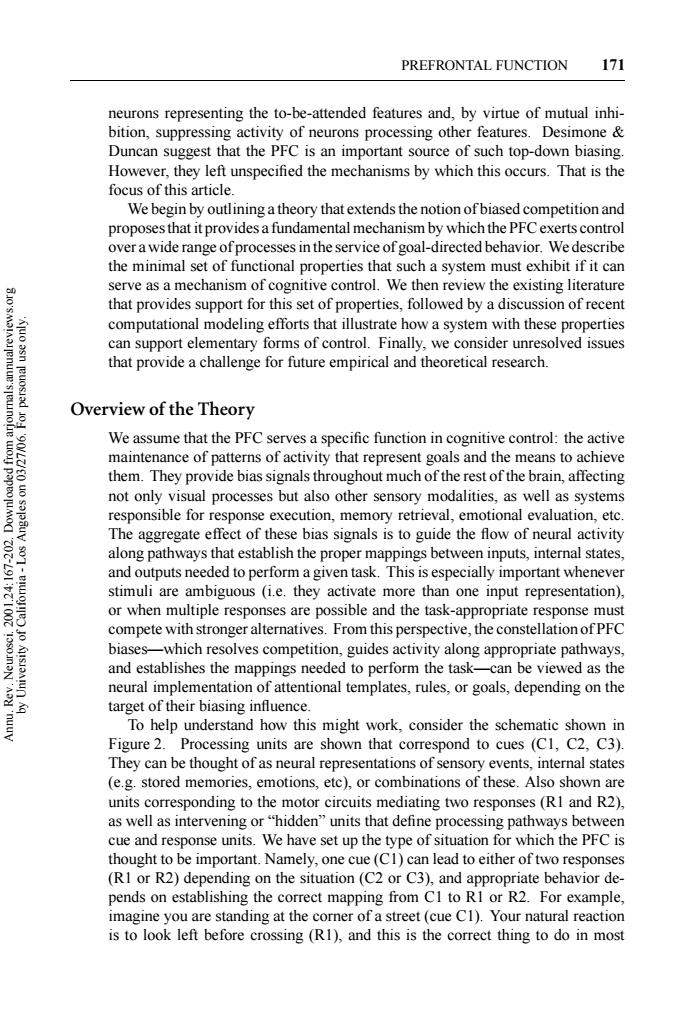正在加载图片...

PREFRONTAL FUNCTION 171 neurons representing the to-be-attended features and,by virtue of mutual inhi bition,suppressing activity of neurons processing other features.Desimone Duncan suggest that the PFC is an important source of such top-down biasing. However,they left unspecified the mechanisms by which this occurs.That is the focus of thisarticle. We begin by outlining a theory that extends the notion of biased competition and proposes that it provides a fundamental mechanism by which the PFC exerts control over a wide range ofprocesses in the service of goal-directed behavior.We describe the minimal set of functional properties that such a system must exhibit if it can serve as a mechanism of cognitive control.We then review the existing literature that provides suppor sion of recent computational modeling efforts that illustrate how a system with these properties can support elementary forms of control.Finally,we consider unresolved issues that provide a challenge for future empirical and theoretical research. Overview of the Theory We assume that the PFC serves a specific function in cognitive control:the active maintenance of patterns of activity that represent goals and the means to achieve them.They provide bias signals throughout much of the rest of the brain,affecting oyisual processes but also other sensory modalities.as well as systems responsible for r exe on,memory retrieva The aggregate effect of these bias signals is to guide the flow of neural activity along pathways that establish the proper mappings between inputs,internal states, and outputs needed to perform a given task.This is especially important whenever stimuli are ambiguous (ie they activate more than one input representation) or when multiple responses are possible and the task-appropriate resp compete w biases-which resolves competition,guides activity along appropriate pathways and establishes the mappings needed to perform the task-can be viewed as the neural implementation of attentional templates,rules,or goals,depending on the target of their biasing influence To heln understand how this Figure 2 They can be thought of as neural representations of sensory events.internal states (e.g.stored memories,emotions,etc),or combinations of these.Also shown are units corresponding to the motor circuits mediating two responses(RI and R2). pro cessing pathy e and response units We have set up the type of situ ation thought to be important.Namely,one cue(C1)can lead to either of two responses (RI or R2)depending on the situation(C2 or C3),and appropriate behavior de- pends on establishing the correct mapping from CI to RI or R2.For example imagine you are standing at the corner of a street(cue C1).Your natural reaction is to look left before crossing(R1),and this is the correct thing to do in most P1: FXZ January 12, 2001 14:38 Annual Reviews AR121-07 PREFRONTAL FUNCTION 171 neurons representing the to-be-attended features and, by virtue of mutual inhibition, suppressing activity of neurons processing other features. Desimone & Duncan suggest that the PFC is an important source of such top-down biasing. However, they left unspecified the mechanisms by which this occurs. That is the focus of this article. We begin by outlining a theory that extends the notion of biased competition and proposes that it provides a fundamental mechanism by which the PFC exerts control over a wide range of processes in the service of goal-directed behavior. We describe the minimal set of functional properties that such a system must exhibit if it can serve as a mechanism of cognitive control. We then review the existing literature that provides support for this set of properties, followed by a discussion of recent computational modeling efforts that illustrate how a system with these properties can support elementary forms of control. Finally, we consider unresolved issues that provide a challenge for future empirical and theoretical research. Overview of the Theory We assume that the PFC serves a specific function in cognitive control: the active maintenance of patterns of activity that represent goals and the means to achieve them. They provide bias signals throughout much of the rest of the brain, affecting not only visual processes but also other sensory modalities, as well as systems responsible for response execution, memory retrieval, emotional evaluation, etc. The aggregate effect of these bias signals is to guide the flow of neural activity along pathways that establish the proper mappings between inputs, internal states, and outputs needed to perform a given task. This is especially important whenever stimuli are ambiguous (i.e. they activate more than one input representation), or when multiple responses are possible and the task-appropriate response must compete with stronger alternatives. From this perspective, the constellation of PFC biases—which resolves competition, guides activity along appropriate pathways, and establishes the mappings needed to perform the task—can be viewed as the neural implementation of attentional templates, rules, or goals, depending on the target of their biasing influence. To help understand how this might work, consider the schematic shown in Figure 2. Processing units are shown that correspond to cues (C1, C2, C3). They can be thought of as neural representations of sensory events, internal states (e.g. stored memories, emotions, etc), or combinations of these. Also shown are units corresponding to the motor circuits mediating two responses (R1 and R2), as well as intervening or “hidden” units that define processing pathways between cue and response units. We have set up the type of situation for which the PFC is thought to be important. Namely, one cue (C1) can lead to either of two responses (R1 or R2) depending on the situation (C2 or C3), and appropriate behavior depends on establishing the correct mapping from C1 to R1 or R2. For example, imagine you are standing at the corner of a street (cue C1). Your natural reaction is to look left before crossing (R1), and this is the correct thing to do in most Annu. Rev. Neurosci. 2001.24:167-202. Downloaded from arjournals.annualreviews.org by University of California - Los Angeles on 03/27/06. For personal use only